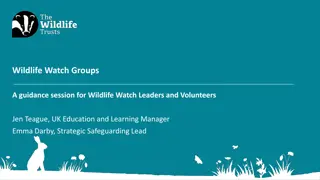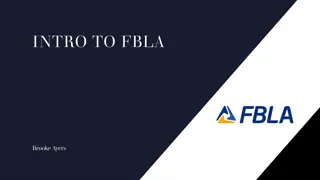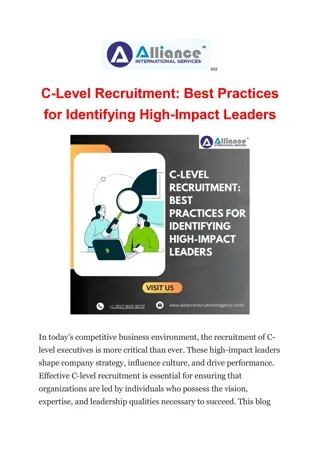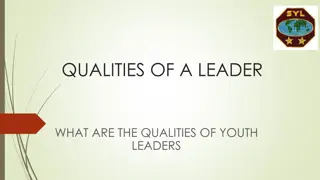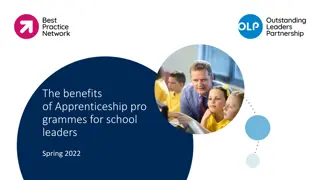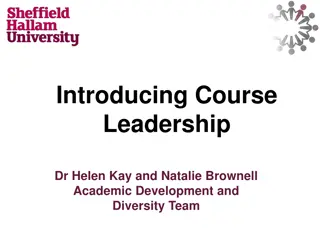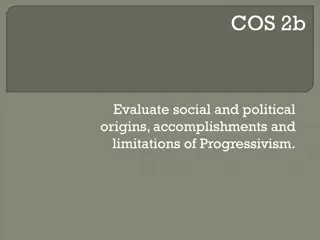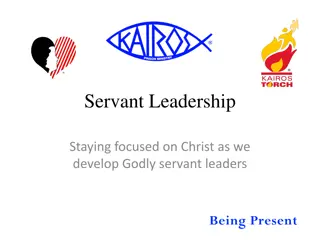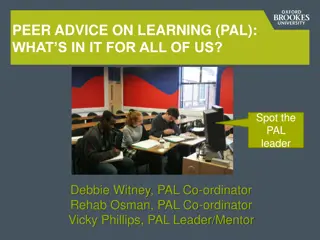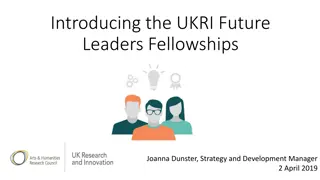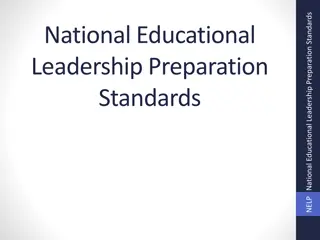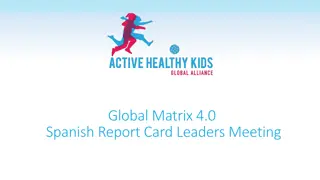BUIDLING FUTURE LEADERS
Succession management in municipalities focuses on building internal capabilities, skills, and talent across management levels to ensure continuity and competitiveness. It involves deliberate efforts to identify future resourcing requirements, encourage individual advancement, and comply with legal requirements. The process incorporates succession planning, recruitment, selection, retention, assessment, and performance development. Objectives include ensuring a continuous supply of skilled leaders, enabling employees to meet career aspirations, and sustainable knowledge transfer. Leadership development, transformation, change agents, and performance management are key opportunities in succession management.
Uploaded on Feb 19, 2025 | 3 Views
Download Presentation

Please find below an Image/Link to download the presentation.
The content on the website is provided AS IS for your information and personal use only. It may not be sold, licensed, or shared on other websites without obtaining consent from the author.If you encounter any issues during the download, it is possible that the publisher has removed the file from their server.
You are allowed to download the files provided on this website for personal or commercial use, subject to the condition that they are used lawfully. All files are the property of their respective owners.
The content on the website is provided AS IS for your information and personal use only. It may not be sold, licensed, or shared on other websites without obtaining consent from the author.
E N D
Presentation Transcript
BUIDLING FUTURE LEADERS Ms Lordie Mateteswa www.salga.org.za
Agenda Succession Management in Municipalities: Opportunities and Challenges Learning And Competency Development The Next Steps www.salga.org.za
SUCCESSION MANAGEMENT DEFINITION A process for the building the internal capability, skills and talent across management level and critical role to ensure continuity and competitiveness . Succession Planning: A process for identifying and planning for future resourcing requirements, depending on current and future organisation requirements Rothwell (2010) defines succession planning as a deliberate and systematic effort by an organisation to ensure leadership continuity in key positions, retain and develop intellectual and knowledge capital for the future, and encourage in individual advancement . www.salga.org.za
Succession Planning Recruitment & Selection Retention Assessment and Performance Development Development www.salga.org.za
Objectives of Succession Management Ensuring continuous supply (short, medium and long term of an adequate number of skilled leaders Enabling leaders, professional and specialists to perform at appropriate levels Ensuring that development and learnings experiences address competencies (skills, knowledge and values) Comply with legal requirements: Skills Development Act and the EE Act Enabling employees to meet their own career aspirations through appropriate flexible career paths, given their competencies, performance levels , potential, values and interests Ensuring sustainable knowledge transfer of employees that are considered retirement risks. Therefore from the above objectives it clear that you cannot separate succession management from talent management and career management www.salga.org.za
OPPORTUNITIES Leadership Development: is a way of giving direction in an organisation by creating alignment of the strategic objective sand a vision of an organisation. Transformation Leadership Change Agents Performance Management: Future focused, regular feedback, continuous discussions (dialogue) Employer Proposition www.salga.org.za
What is needed to prepare Succession Planning and Career Pathing Departmental Organogram Skills Audit Results Performance appraisal forms for all staff within the department Departmental estimates or staff budget Schedule of showing the ages of the current staff and dates of retirement Job descriptions for all posts plus competency based job outcomes for each post -Individual competency profile must be matched against the position requirements www.salga.org.za
Procedure for compiling a Succession Planning document Managers are responsible for talent management Step 1: Review (examine/analyse) the organogram of the department: Which posts are likely to become vacant over the next years owing to retirements (info from skills audit results) Provision should be made for other forms of terminations e.g. resignations, death , dismissals Which posts require specialist technical or formal training and which there are no suitably internal staff members www.salga.org.za
Procedure for compiling a Succession Planning document Step 2: Draft organogram should reflect new posts that will be needed and in the next 1-5 years as reflected in the IDP. How can we improve the current staff organogram to meet future needs also bearing in mind reality of availability of funds www.salga.org.za
Procedure for compiling a Succession Planning document Step 3: Identify potential successors who could be groomed for new posts or becoming vacant as a result of retirements, resignations etc. You should target high priority jobs. -Information can be obtained from the Skills Audit results and performance appraisals which eliminates subjectivity of managers Create succession pools: which consist of individuals who have been identified as potential successors to identified and who have demonstrated high performance and learning agility -learning agility: individual s ability to learn quickly in a new environment, continuously improve and adapt easily to new challenges . Previously disadvantaged employees should be given preference where necessary to comply with the provision of Municipalities employment equity plan www.salga.org.za
Procedure for compiling a Succession Planning document Step 4: Competency Development Plan (CDP): which competencies to be developed or improved, how (process), expected outcomes and when (time frame). The purpose of the CDP is to develop and improve competency of the employee in order that future staff needs are met. Create financial enablers to competency development: offering bursaries, allocating more than the minimum requirement of 1% of the payroll (increasing skills development budget) Alignment to legislation and internal policies www.salga.org.za
Procedure for compiling a Succession Planning document Step 5: Where additional training is necessary, suitable training courses must be identified and arrangements made for the identified employees to attend It is important that the training courses should cover all competencies and that at the end of the course, the employee must be able to deliver the performance outcomes required for the job After completion of training employees should be given an opportunity to implement what was learned, this will also assist us in measuring the effectiveness of the training www.salga.org.za
Procedure for compiling a Succession Planning document Step 6: Leaders should provide internal training opportunities Leaders as talent managers can also provide on the job training, job rotation, acting opportunities when present incumbent is on leave (The supervisor can be able to establish whether the employee has the ability to meet performance standards set for the post) www.salga.org.za
Procedure for compiling a Succession Planning document Step 7: Deployment: a process which exposes individuals to learning assignments in specific developmental opportunities over a period time to accelerate development If no suitable on job training within the municipality exists, arrangements can be made to deploy identified potential successors or leaders to be send to other municipality for limited periods Some are willing to assist in this regard, provided that there are no cost implications for them www.salga.org.za
Procedure for compiling a Succession Planning document Step 8: Identified future leaders can a be allowed to work directly under a qualified and experienced employee within the municipality the would mentor and coach him/her, thus transferring skills This will enable competency development or acquiring skills at a limited cost www.salga.org.za
Snap shot of compiling a Career Pathing documents Career Pathing: means ensuring that each staff member s potential is fullest extent and that there is a career mapped out for him or her in the municipality in line with organisational strategic objectives. Step 1: Leader should ascertain what are the employees ambitions and aspirations and how great they are through consultation sessions and performance appraisals Step 2: The employee aspirations must be compared with his/her current performance and improvements needed must be set out Step 3: Provide opportunities for future leaders to develop the required competencies to progress to higher levels or realise their full potential. Provide possible career path documents (using the organogram, skills audit results, organisational strategic objectives etc.) Step 4: Evaluate the competency: have they acquired the necessary skills and competence to perform the key task , he/she then she may move to the higher level of competency in his/her career path. www.salga.org.za
Indicators to measure the success of Succession Management Centralisation of talent and succession information will be shared across various disciplines and divisions Systematic identification of successors Leaders promoting and rotating employees rather than keeping employees tied down to one specific area or business All key managerial and professional talent have individual personal development plans that are relevant and up-to-date Career paths providing vocalisation across specialised paths and across the organisation Increased retention of employees as identified in various succession pools. Diverse workforce across all occupational levels An integrated development process for succession pools aligned with a career growth plan Increased number of high priority positions with Ready now candidates Increased number of high roles filled internally www.salga.org.za
The importance of Leadership development in succession planning Leadership is defined as a way of giving direction in an organisation by creating alignment of the strategic objectives and a vision of an organisation. Lopez (2014) defines leadership as the competencies and processes required for enabling ordinary people to do extraordinary things in the face of adversity and constantly turn in high performance to the benefit of themselves and the organisation. Transformation Leadership: fits the needs of todays work group who want to be inspired and empowered and succeed in terms of uncertainty by a leader who is charismatic, vision driven and inspires his/her followers. -Characteristics of transformational leadership: idealised influence, inspirational motivation, intellectual stimulation (thought provoking), individualised considerations Be a Change Agent: Was I able to use my gifts and talent to move the organisation in a particular way (involves self-awareness and self-introspection) Mentors and Coaches: Providing advice and support to future leaders www.salga.org.za
PERCEIVED CHALLENGES TO TALENT MANAGEMENT L Koketso & B Rust (2011): City of Cape Town Talent attracted to municipality in that it offers job security Sources of frustration that led to top talent loss : -Lack of capacity to adapt to the organisation culture, lack of transformation, poor implantation of affirmative action measures and the unsettling political scenario (Sec 56 managers): - Lack of management support: no coaching or mentoring Career Management: No opportunity provide to discuss their careers in terms progression within the organisation no clear outline of where I will be or where I could be in the next 5 to 10 years I want know what proficiency levels are required and what competencies are required to be successful in the next level www.salga.org.za
PERCEIVED CHALLENGES TO TALENT MANAGEMENT Job, skills and competencies match: talent misplacement, Failure by organisations to match talent to jobs -Mismatch between knowledge, skills and job placement impacts on the moral of employees concerned but also on the mandate of delivering services to the local community members - Lack of skills audit not conducted regularly : need to continue to assess available talent through skills audits or talent-gap analysis Investment in top achievers: are we extending their job descriptions to make it more meaning than just what is required Employee Recognition: performing beyond the call of duty -Management can issue individuals employees letters of appreciation, issue a certificate of recognition -Management feedback lacking Reward and compensation: look beyond monetary (e.g. performance bonuses, scarcity allowances) to other ways of compensating talent e.g. Conducting skills audit to ensure that they are not misplaced in the organisation which will also assist in management of careers and progression in the municipality Work life Balance: Flexi-time schedule not practiced and impacts of family life then employees leave the municipality. www.salga.org.za
NEXT STEPS Leadership development is key towards proper implementation of talent development, succession management and career development. - Leadership development through succession planning contributes to employee satisfaction and improves organization overall outcomes Continuous learning and Competency development: To retain staff and to keep up with the changes in the world of work Succession planning and its implementation is the responsibility of all managers as leaders and talent managers Deployment outside the municipality e.g. to other municipalities, spheres of government and the private sector Each role player in the municipality must execute its responsibilities by being effective, efficient and accountable. Responsibilities should always be aligned to organisational objectives. e.g. the responsibilities of employees: commit themselves to participation in training programs What lessons can we take from the perceptions of employees in order to improve policies, procures and practices and build future leaders Employer proposition: relook into the organisational culture and values build a competitive advantage in the competition of talent in the labour market www.salga.org.za
NEXT STEPS Recommendations informed by research studies: Qhibi T. (2017)(Wits University) Pila M, C Shultz and Dachapalli (2016) (Journal of problems & perspective in management) Municipalities need to invest in employees by paying attention to competency levels through talent development initiates Commitment by leaders in talent development initiatives to drive the processes and integrate it with overall objectives of the municipality Benchmarking with municipalities which have successfully implemented talent development Creating a talent management culture for the whole organisation , by capacitating leaders and employees Create a conducive environment for excellent performance and job satisfaction www.salga.org.za
NEXT STEPS There should be personal involvement of top management in terms of personal accountability to grow leaders. The organisation should develop and implement workforce transition plans, and Invest in credible forecasting of we what the future holds. Managers may be measured thorough their key performance indicators in terms of how may promotable employees they attract , develop, retain in their areas of responsibility SALGA: should develop a standardised talent development policy for uniformity in the Province or Country. SALGA AND GOGTA to collaborate with municipalities to create a forum (information sharing platforms) which will meet on a quarterly basis to assist failing municipalities and encourage progress. www.salga.org.za
THANK YOU FOR THE OPPORTUNITY!!! www.salga.org.za



